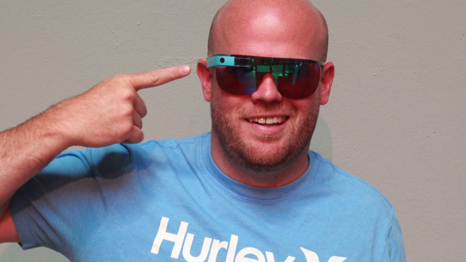The Cyclorama was set up with different Glass testing areas that highlighted some of the wearable device’s best features.
The first was an app called GuidiGo, a museum touring app for Glass that uses QR codes to give info on what you may be looking at in a museum, or, in the case of the Boston Glass event, a history of the development of Google Glasses. Next, I was given the chance to trial an app that is paired with the 94Fifty smart sensor basketball. The app is meant to be a “teaching tool” for coaches to gauge the trajectory and arc of a basketball shot. Lastly, I got to demo the traveling app Word Lens that translates signs from various languages into a user’s native language.
Of the demos, the Word Lens one was most impressive, showing the potential for Google Glass. However, Word Lens is available for both Android and iOS mobile devices and is just as impressive translating signs in real-time on a mobile device, if not more so, because, well…usability.
The problem I found with Google Glass is that it is just not that intuitive. At all times, the sensation is similar to looking at a rear-view mirror while driving, except the rearview mirror is full of kind-of-distracting computer menus, unnatural-feeling camera viewfinders, or images of one kind or another.
The 94Fifty app really emphasized the needlessness of Google Glasses, and it is meant to showcase the device. First, it’s odd to have a face computer in your periphery if you’re trying to shoot a basketball. It’s beyond unnatural and distracting. Second, I’m not really sure the point. Anyone who has ever shot a basketball knows that it is 99 percent feel and muscle memory. I’m not really sure what someone is supposed to do with the data that their arc is off by a degree or two.
The functionality of Google Glass doesn’t seem to come close yet to making it a utility that makes sense. Plus, its a weird computer on your face as I model above. Even the Diane von Furstenberg designs I tried couldn’t make Google Glass cool, even if I had serendipitously worn a shirt that matched the sunglasses.
I was also given the chance to talk with “Jess,” a Glass explorer, about the device. She uses it for everyday tasks but also in her role as a post-doc researcher at Brandeis. She uses the Google Glass to record various lab technique “for training undergrads and other colleagues.”
When I asked Jess if she wears them all the time, she said that sometimes she doesn’t wear the Glass because often she will end up having to explain the device to people, and if she is in a rush, that can disrupt her day.
I also asked her if she had any bad experiences, like those that have happened with Google Glass users in San Francisco and other places (ValleyWag has a treasure trove of these stories). Jess said, “99 percent of my experiences have been really overwhelmingly positive, but I have had a couple that were not so happy.” Both had to do with people thinking she was video taping or taking pictures of them.
She made a good point, however, by adding, “To be honest, more people have video taped me without my permission if I’m wearing Glass than I’ve ever even thought about.”
While the event was a great chance for people to test Google Glass, it also clearly showed that the device has a long way to go to mass acceptance. And, after trying the device for myself, I’m not sure that will ever happen.








Leave a Reply
You must be logged in to post a comment.